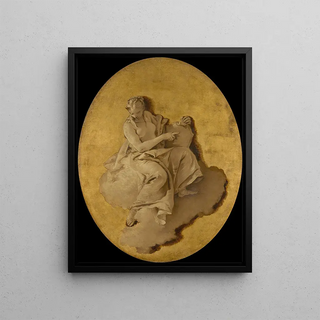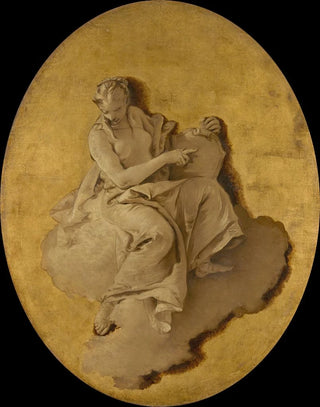Art print | Allegorical figure of a woman with a shield or a mirror - Giovanni Battista Tiepolo


View from behind

Frame (optional)
Giovanni Battista Tiepolo's art print, "Figure allégorique d'une femme avec un bouclier ou un miroir," stands as a true ode to beauty and the complexity of the human condition. In this depiction, Tiepolo invites us to immerse ourselves in a universe where mythology and allegory intertwine, creating an atmosphere that is both mystical and evocative. The female figure, central to the composition, embodies universal values such as wisdom, strength, and protection, while also evoking themes of duality and reflection. The presence of the shield and mirror, symbols of defense and truth, give this art print a depth that transcends mere appearance, inviting the viewer to introspective contemplation.
Style and uniqueness of the art print
Tiepolo is distinguished by his flamboyant baroque style, characterized by vivid colors and radiant light. In "Figure allégorique d'une femme avec un bouclier ou un miroir," the artist demonstrates exceptional mastery of chiaroscuro, creating a play of lights that highlights the delicate contours of the figure. The flowing drapery and meticulous facial details testify to his skill in capturing human beauty in all its splendor. The composition, both dynamic and balanced, guides the viewer's gaze through the piece, gradually revealing the multiple layers of meaning. Every element, from the shield to the woman's posture, contributes to a rich visual narrative, where formal beauty serves as a vehicle for deeper ideas about the human condition and the individual's place in the world.
The artist and his influence
Giovanni Battista Tiepolo, one of the masters of the 18th century, established himself as an emblematic figure of baroque art. Originating from Venice, he managed to incorporate the influences of his time while developing a personal style that is uniquely his own. Tiepolo had a significant impact on his contemporaries and future generations, notably through his bold use of color and light. His works, often commissioned for palaces and

Matte finish

View from behind

Frame (optional)
Giovanni Battista Tiepolo's art print, "Figure allégorique d'une femme avec un bouclier ou un miroir," stands as a true ode to beauty and the complexity of the human condition. In this depiction, Tiepolo invites us to immerse ourselves in a universe where mythology and allegory intertwine, creating an atmosphere that is both mystical and evocative. The female figure, central to the composition, embodies universal values such as wisdom, strength, and protection, while also evoking themes of duality and reflection. The presence of the shield and mirror, symbols of defense and truth, give this art print a depth that transcends mere appearance, inviting the viewer to introspective contemplation.
Style and uniqueness of the art print
Tiepolo is distinguished by his flamboyant baroque style, characterized by vivid colors and radiant light. In "Figure allégorique d'une femme avec un bouclier ou un miroir," the artist demonstrates exceptional mastery of chiaroscuro, creating a play of lights that highlights the delicate contours of the figure. The flowing drapery and meticulous facial details testify to his skill in capturing human beauty in all its splendor. The composition, both dynamic and balanced, guides the viewer's gaze through the piece, gradually revealing the multiple layers of meaning. Every element, from the shield to the woman's posture, contributes to a rich visual narrative, where formal beauty serves as a vehicle for deeper ideas about the human condition and the individual's place in the world.
The artist and his influence
Giovanni Battista Tiepolo, one of the masters of the 18th century, established himself as an emblematic figure of baroque art. Originating from Venice, he managed to incorporate the influences of his time while developing a personal style that is uniquely his own. Tiepolo had a significant impact on his contemporaries and future generations, notably through his bold use of color and light. His works, often commissioned for palaces and






